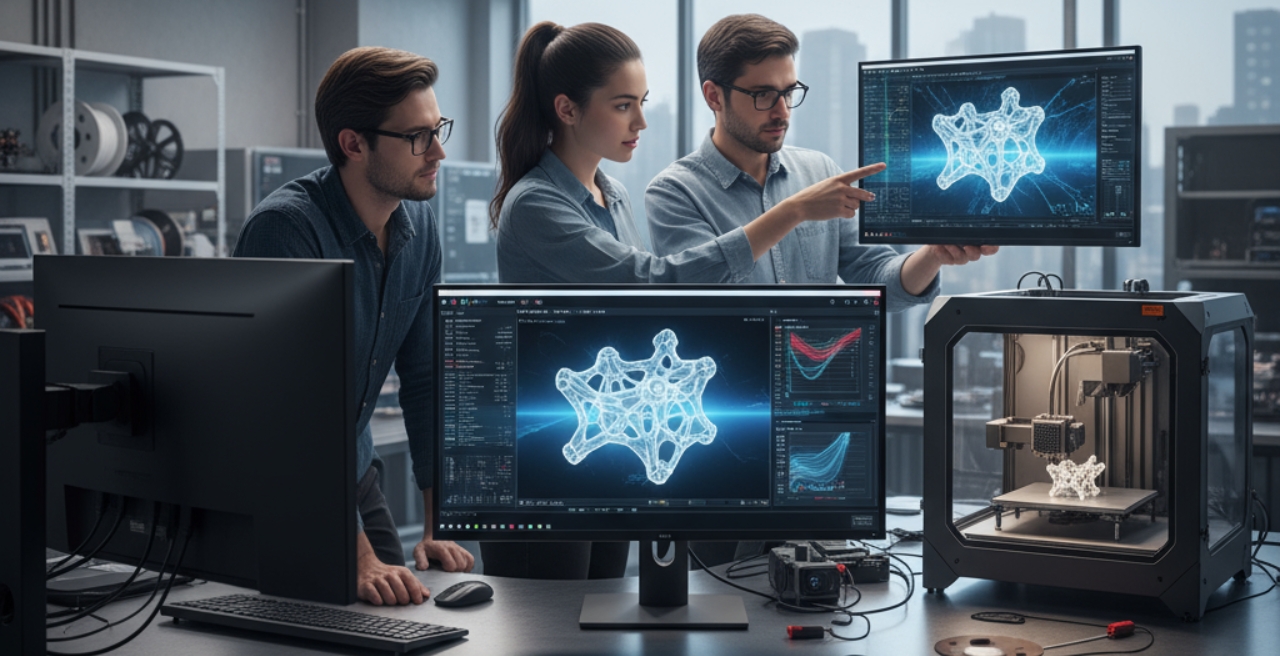Additive manufacturing (AM), commonly known as 3D printing, is transforming the way engineers conceptualize and fabricate components.
Spanning industries from aerospace to healthcare, it facilitates the production of intricate, lightweight, and tailored parts that conventional techniques cannot accomplish.
However, designing for 3D printing is not merely a matter of exporting a CAD file. It requires a comprehensive understanding of materials, thermal behaviour, support structures, and build orientation.
Consequently, simulation in additive manufacturing has become essential, as it forecasts and enhances the entire printing process prior to the commencement of production.
Understanding Design for Additive Manufacturing (DfAM)
Design for Additive Manufacturing (DfAM) focuses on creating components that maximize the advantages of 3D printing technology. While it fosters enhanced creativity, it also presents new challenges, including:
- Residual stresses resulting from quick heating and cooling
- Warping and distortion throughout the construction process
- Excessively intricate support needs
- Unpredictable behaviour of materials
In this context, simulation tools assist engineers in anticipating these problems and improving designs prior to the unnecessary expenditure of time or resources.
Why Simulation Is Essential in 3D Printing
Simulation enables engineers to conduct virtual tests prior to physical printing. This approach minimizes costs, decreases trial-and-error, and enhances the reliability of parts.
Advantages of simulation in additive manufacturing include:
- Anticipating thermal and structural deformations
- Enhancing print orientation and support configuration
- Minimizing failed builds and material waste
- Confirming strength and stiffness prior to production
- Reducing development time while elevating quality
In summary, simulation for 3D printed components accelerates workflows, increases intelligence, and enhances predictability.
Key Simulation Applications in Additive Manufacturing
1. Process Simulation
During the printing process, thermal gradients induce stress and deformation. Process simulation aids in forecasting:
- Temperature distribution
- Regions susceptible to warping
- Adjustments required for precision
2. Structural Analysis
Following the printing process, components must operate dependably. Software such as MSC Nastran and Marc are utilized to simulate:
- Stress, strain, and fatigue
- Vibration and impact response
- Load-bearing capacity in actual conditions
3. Topology Optimization
This method employs simulation-driven design to eliminate superfluous material while preserving strength.
- Attain lightweight components
- Minimize expenses and material consumption
- Enhance performance through cutting-edge geometries
4. Support Structure Optimization
Supports are crucial for maintaining print stability; however, they also raise costs and extend production time. Simulation aids in:
- Reducing the amount of support material used
- Enhancing placement for optimal balance
- Streamlining post-processing
5. Thermal and Residual Stress Analysis
Sophisticated tools such as MSC Simufact Additive and Hexagon’s Digimat are utilized to simulate:
- Residual stress accumulation
- Shrinkage and deformation
- Adjustments to geometry for correction prior to printing
Practical Design Tips for 3D Printed Parts
To achieve optimal outcomes from additive manufacturing simulation, adhere to the following best practices:
- Carefully orient parts to minimize distortion and enhance surface finish.
- Where feasible, simplify geometry to increase reliability.
- Integrate lattice structures to create lightweight, high-strength designs.
- Conduct multiple simulation scenarios to evaluate different outcomes.
- Utilize simulation data to validate materials for heat, load, and fatigue.
These minor adjustments ensure that designs are print-ready, precise, and efficient.
Integrate Simulation Early in the Design Process
Numerous engineers typically employ simulation solely after the design of a component; however, its effectiveness is significantly enhanced when utilized at an earlier stage.
Benefits of early simulation include:
- Avoidance of expensive reprints
- Reduction of material and time wastage
- Facilitation of quicker design iterations
- Promotion of innovative and optimized geometries
Incorporating simulation into additive manufacturing from the initial concept through to production guarantees expedited, data-informed decision-making.
The Future of Additive Manufacturing Simulation
Contemporary simulation tools are advancing swiftly.
AI-driven predictive modelling, digital twins, and real-time process monitoring are transforming the methods by which engineers design and print.
Platforms such as Hexagon’s MSC One and Simu fact Additive now integrate process, structural, and thermal simulations within a single ecosystem-rendering 3D printing simulation more precise, cohesive, and accessible than ever before.
Conclusion
Creating designs for additive manufacturing necessitates a combination of creativity and accuracy.
Utilizing simulation tools for 3D printed components allows engineers to forecast performance, reduce risks, and enhance each layer prior to the commencement of printing.
Simulation serves not merely as a verification phase; it acts as a facilitator of design that transforms innovative concepts into dependable, high-performance products.

















